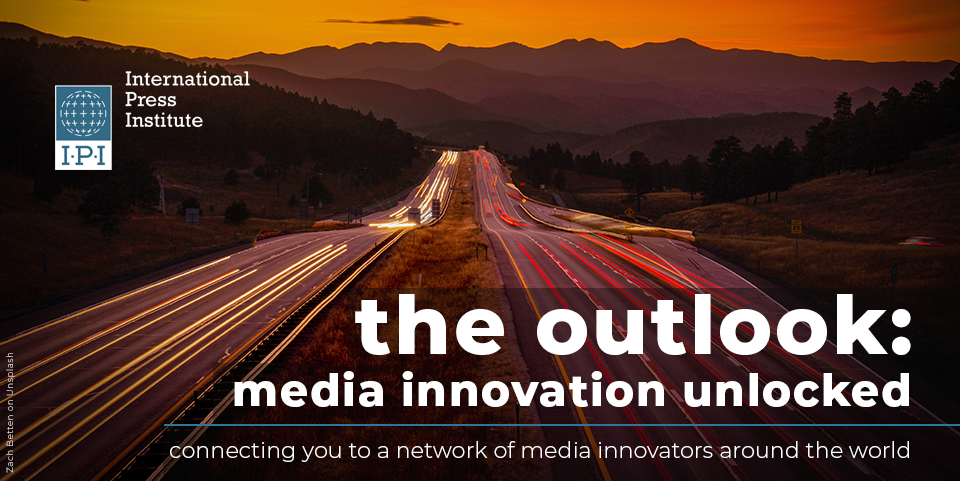This text comes from IPI’s newsletter The Outlook. Click here to sign up to receive future editions direct to your inbox
This is The Outlook, IPI’s media innovation newsletter, where we take a look at strategies and tools for innovation and business development, and learn from newsrooms that are implementing them.
We’ve previously written about the importance of feedback loops. In this week’s newsletter, we look at how to create tools that make it a reality.
The challenge: Making feedback loops part of your workflow
Even for organizations that buy into the value of audience input, what does it look like in practice?
Portuguese local media organization ALMADENSE already knew that their readers’ views mattered, but as a small team, when they joined IPI’s New Media Incubator they weren’t sure how best to act on that.
They got started with a simple task: adding a new page to their website, accessed by a button (‘Talk to Us’) visible from every page. Even the title is a contrast to a traditional ‘Contact us’ page, implying a dialogue. Instead of just providing contact details they give clear examples that tap into readers’ needs (for example, inviting them to publicize an event or initiative, and to submit information they would like verified, among other things).
 The editorial team at ALMADENSE.
The editorial team at ALMADENSE.
The solution: Identify the opportunity in audience input for you.
Tools should do three things:
- Be easy and intuitive to use
- Explain when, and how, you want to hear from your audience
- Give an idea of how you will act on their input.
At ALMADENSE, readers have already used the contact form to submit their ideas and questions.
This has helped identify key topics of concern, for example when they received a high volume of questions after a change in management of the local public transport company, or a tip-off about a potentially illegal area of clandestine housing.
Because the form specifically invites input from those publicizing their own event or achievement, the form has helped the team to foster community by celebrating their readers – for example, when local athletes or artists have notified them of an achievement or recognition.
There have even been cases when readers have submitted their thoughts in such a way that ALMADENSE has chosen to publish them as opinion pieces (with permission). Even better, these articles have been widely read and engaged with.
Morais explains: “I think people relate because these are ordinary readers, so what they write about are things that others relate to” – perhaps more so than local public figures.
💡The Takeaway: It doesn’t matter how much you want to be audience-centered; it’s only truly going to happen once you’ve worked out where the value lies for you and for readers.
Once you’ve done this, it’s simply a case of adapting based on your own resources.
Morais has more ideas for ALMADENSE’s future, which range from low-effort (publishing social media posts that highlight the possibility for reader input) to larger projects (running a stall at local events, or hosting debates on hot local issues). But the ball is already rolling.
News from IPI’s Media Sustainability Team
We are pleased to be launching the Innovation and Product Roadmap, a resource that will support independent media leaders with step-by-step guidance on how to future-proof your business! It’s been produced in collaboration with our friends at Report For The World and the full roadmap will be released in May. You can read more about it on the IPI website, and as a newsletter subscriber you’ll be among the first to receive it when it goes live.
We also have two exciting and contrasting innovation updates from independent newsrooms in our network. Kosovo 2.0, Kosovo’s first blogging platform, has now launched the country’s first news membership programme – read about it here.
And andererseits, the Austria-based news outlet written with and for people with disabilities, published their first accessible-language print magazine, with 35,000 copies delivered directly to social institutions to ensure that people with learning disabilities can access independent information.
Funding opportunities for media
- The Fund for Investigative Journalism is open to US-based journalists with an idea for a high quality, impactful investigative reporting project. Grants of up to $10,000 for expenses are awarded several times a year and the next deadline is 29 April.
- The Internationale Journalisten-Programme (IJP)’s Marion Gräfin Dönhoff Journalism Fellowship is a chance for journalists between the ages of 20 and 35 from Belarus, Ukraine, Russia, Georgia, Armenia, Moldova, Uzbekistan, Kazakhstan and the Baltic States to spend eight weeks at an Eastern European or German host media, with €3,800 to cover expenses. The deadline is 30 April.
- The Vienna Media Initiative offers small media companies and self-employed journalists in Austria the chance to apply for Media Start funding of up to €10,000 for for training and further education, training and consulting, and expenses. The deadline is 30 April.
- There is a 9 May deadline for entries to the Online News Association’s 2024 Online Journalism Awards recognizing excellence in digital reporting. There are several categories including Excellence in AI Innovation, Excellence in Social Media Engagement, the Gather Award in Community-Centered Journalism and more. Entries are paid, with reduced fees for students, micro newsrooms and ONA members.

